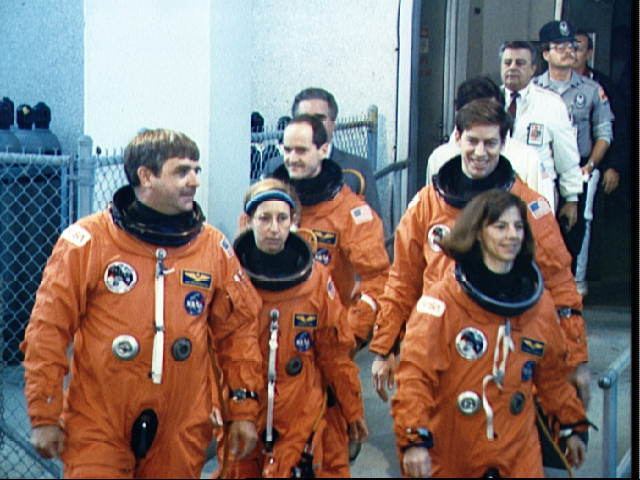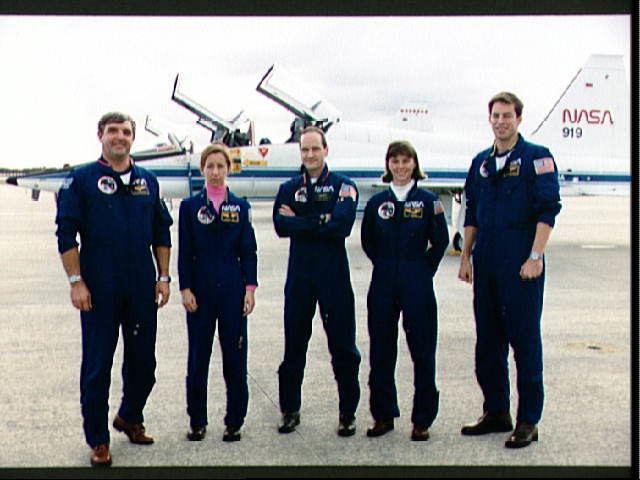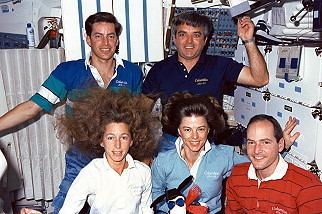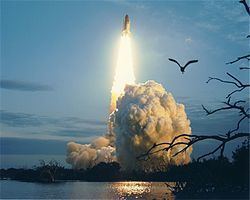COSPAR ID 1990-002A Orbits completed 172 Apogee 361,000 m Landing date 20 January 1990 | SATCAT no. 20409 Period 1.5 hours Dates 9 Jan 1990 – 20 Jan 1990 Launch date 9 January 1990 | |
 | ||
Mission type Satellite deploymentSatellite retrieval Mission duration 10 days, 21 hours, 36 seconds Distance travelled 7,258,096 kilometres (4,509,972 mi) Members | ||
Space shuttle flight 33 sts 32 post flight presentation
STS-32 was the 33rd mission of NASA's Space Shuttle program, and the 9th launch of Space Shuttle Columbia. Launched on 9 January 1990, it marked the first use of Launch Pad A at Kennedy Space Center's Complex 39 since 1986; it also marked the first use of Mobile Launcher Platform No. 3 (MLP-3) in the Space Shuttle program. STS-32 was, at the time, the longest shuttle mission yet conducted, with a duration of nearly 11 days. Before STS-32, the only mission of the same duration had been STS-9 in 1983. On 20 January 1990, STS-32 executed the third night landing of the shuttle program.
Contents
- Space shuttle flight 33 sts 32 post flight presentation
- Sts 32 mission highlights resource tape
- Launch preparations
- Mission summary
- Mid deck payloads
- Mission insignia
- Wake up calls
- References

Sts 32 mission highlights resource tape
Launch preparations

Launch Complex 39A was modified extensively in preparation for the launch, with STS-32 being the first launch from the refurbished pad since STS-61-C in 1986. NASA made improvements to the crew emergency egress system and the shuttle payload room, increased anti-freeze protection for the water systems, installed debris traps used during propellant loading, and added more weather protection features and an umbilical to provide power, instrumentation and controls to the heaters for the solid rocket booster field joints.

MLP-3, the oldest of the three Apollo-era launch structures, also underwent extensive remodeling for use with the shuttle. These modifications included the removal of the umbilical tower, the reconfiguring of three exhaust holes, and amendments to the electrical and mechanical ground support systems.
Mission summary

STS-32 launched from Kennedy Space Center (KSC), Florida, on 9 January 1990 at 7:35:00 am EST. The launch was initially scheduled for 18 December 1989, but was later postponed to allow the modifications to Pad A to be completed and verified. The second scheduled launch, on 8 January 1990, was aborted due to weather conditions. Columbia had a mission launch weight of 255,994 lb (116,117 kg).

The primary objectives of the mission were to deploy the Syncom IV-F5 defense communications satellite (also known as Leasat 5), and to retrieve NASA's Long Duration Exposure Facility (LDEF), whose retrieval had been delayed for 4 1⁄2 years by scheduling changes and the Challenger disaster of 1986. Syncom IV-F5 was deployed on the second flight day, and a third-stage Minuteman solid perigee kick motor propelled it into a geosynchronous orbit. Dunbar retrieved the LDEF on the fourth day of the flight using the shuttle's Remote Manipulator System. The timeliness of the retrieval was of critical importance, because a high rate of solar flux had increased the density of the LDEF's orbital environment and accelerated its rate of orbital decay. Specialists who carefully monitored the stability of the craft's orbit had anticipated that if the LDEF was not retrieved in time, it would pass too low for the shuttle to safely reach, and could be destroyed during re-entry in February 1990. Thus, the mission's exact liftoff time was determined about 12 hours before launch, using the latest tracking data on LDEF. It was flown on a 352 kilometers (219 mi) orbit inclined 28.5 degrees to the equator.
The crew performed a 4 1⁄2-hour photographic survey of the free-flying structure, which held 57 science, technology and applications experiments. The 12-sided cylinder, about the size of a small bus, was then berthed in the orbiter's payload bay for return to Earth.
NASA had planned to acquire data on the crew members' exposure to long periods of zero gravity, and its effects on the crew's performance while landing the orbiter after an extended mission. STS-32 set a new shuttle duration record of nearly eleven days. An orbiter kit was developed to allow the shuttle to operate for up to 16 days in Earth orbit, and would later make its debut on Columbia's STS-50 mission in 1992.
The retrieval of LDEF was filmed with an IMAX camera, and appeared in the IMAX film Destiny in Space in 1994. Earth observation footage from the camera also appeared in the 1991 film Blue Planet.
Columbia landed safely on 20 January 1990 at 1:35:37 am PST on Runway 22 of Edwards Air Force Base, California. The shuttle had a landing weight of 103,571 kilograms (228,335 lb). The roll-out distance was 3,271 metres (10,732 ft), and the roll-out time was 62 seconds. The orbiter returned to KSC on 26 January 1990.
Mid-deck payloads
In addition to the Syncom IV-F5 satellite, STS-32 carried a number of mid-deck scientific payloads, some of which had already been flown on previous shuttle missions. The experiments included:
Mission insignia
The three stars on the left and two stars on the right of STS-32's insignia symbolized the flight's numerical designation in the Space Transportation System's mission sequence.
Wake-up calls
NASA began a tradition of playing music to astronauts during the Gemini program, and first used music to wake up a flight crew during Apollo 15. Each track is specially chosen, often by the astronauts' families, and usually has a special meaning to an individual member of the crew, or is applicable to their daily activities.
